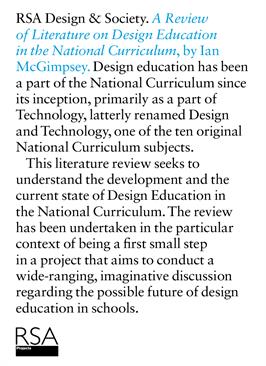Design education has been a part of the National Curriculum since its inception, primarily as a part of Technology, latterly renamed Design and Technology, one of the ten original National Curriculum subjects. This literature review seeks to understand the development and the current state of Design Education in the National Curriculum. The review has been undertaken in the particular context of being a first small step in a project that aims to conduct a wide-ranging, imaginative discussion regarding the possible future of design education in schools.
RSA Design & Society is a programme guided by an idea of design as a capacity that is central to citizenship in the UK in the early 21st century. This reconceived notion of design as a shared capability and as democratic is, at one level, an attempt to create greater congruence with contemporary social, ecological and economic parameters for a discipline often captured and sustained by mass consumerism.
However, at another level, RSA Design & Society is an attempt at more than sustaining a discipline as it transitions to new circumstances. It is an attempt to utilise those circumstances as drivers towards a different design, one that provides insight into new models of production, consumption, service provision, systems development and collective problem solving.
Among the increasingly unstable and uncertain edifices of the 20th century, RSA Design & Society attempts to understand how design, as a widely shared and cultivated human capability, could help us find the grounds for future building. And given the concern with design as a capacity central to social progress, RSA Design & Society now seeks to consider the role of the education system, and specifically compulsory schooling, in fostering this capacity.
Design education has been a part of the National Curriculum since its inception, primarily as a part of Technology, latterly renamed Design and Technology, one of the ten original National Curriculum subjects. This literature review seeks to understand the development and the current state of design education in the National Curriculum. The review has been undertaken in the particular context of being a first small step in a project that aims to conduct a wide-ranging,imaginative discussion regarding the possible future of design education in schools.
Aims of the review
With this purpose in mind, the top level aim for the review was to
understand how ‘design’ has been interpreted within the National Curriculum. The review was asked to focus in particular on:
-
How policy has framed design as a discipline within the curriculum, including its origins and development over time,
-
Academic research into the how the subject has been planned and taught, including its effectiveness.
With reference to point 1 it is acknowledged that effectiveness might not always refer to aims as they are ‘officially’ defined by policy texts, including the National Curriculum. Effectiveness may also be interpreted in relation to other aims or legitimations of design as a part of the curriculum asserted by, for example, teaching 3 Literature Review professionals or other groups with an interest in advocating design.
Within this broad focus, the review was also asked to consider several themes within wider design and education discourses:
-
The nature of design as a discipline – is it only about product design?
-
Prominent policy agendas in relation to the curriculum, seeking to establish priority or high status subjects, notably through STEM and the ‘English Baccalaureate
-
Growing curriculum flexibility and interaction between subjects
-
The nature of the knowledge taught by schools
-
How the place of design is legitimised on the curriculum with reference to national economic pressures, personal development and so on.
pdf 171.3 KB
Contributors

